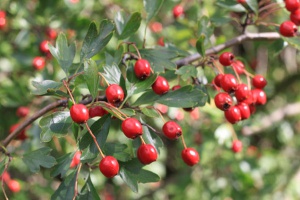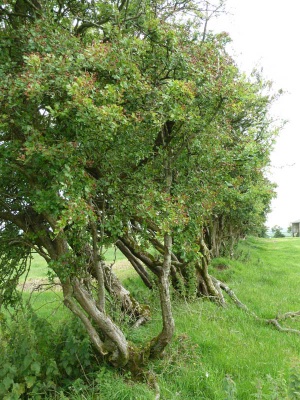Hawthorn
Contents
Origin and Description
Hawthorn plants are a part of the rose (rosaceae) family, and can be found growing in the wild in Europe, N. Africa, Asia, southern Canada and in the United States. They can grow from low sunny lands to high mountain elevations up to 8,500 feet.
The plants, which often grow into shrubs or small trees, have stiff toothed leaves, and sharp thorns on the stems and branches. They also have spectacular white, and sometimes pinkish flowers which are extremely sweet smelling. The fruit or berries are usually a reddish color, but sometimes yellow and very occasionally black or bluish. The appearance is similar to tiny apples.
Some of the other names for Hawthorn are Mayflower, May Bush, Thorn Plum, Thornbush, Western Black Hawthorn and Cockspur Thorn.
Actions
Hawthorn is used as an anti-spasmodic (prevents/relieves spasms), astringent, cardiac (heart tonic), diuretic (increases urine flow), emmenagogue (regulates menstrual flow), hypertensive (increases blood pressure), hypotensive (reduces blood pressure), sedative and tonic. Parts commonly used are the berries and bark.
Medicinal Uses
There's a variety of ways that Hawthorn is used for health related treatments. It can increase oxygen utilization by the heart, it increases enzyme metabolism in the heart muscle and acts as a mild dilator of coronary vessels. This herb also serves as a peripheral vasodilator (dilates the blood vessels away from the heart, therefore lowering blood pressure).
Hawthorn is a cardiac tonic that is used for heart weakness, angina pectoris, valve murmurs and enlarged heart. It also increases blood flow, which allows the heart to function with less oxygen.
The herb can also effectively be used to treat cases of restlessness and insomnia. It can also be utilized for the treatment of intestinal worms or infections. Topical application shows good results for boils, sores, ulcers, itching and frostbite. Following are just some of the conditions that may be helped with the use of Hawthorn.
- Adrenal weakness
- Angina Pectoris
- Arrhythmias
- Arteriosclerosis
- Blood Pressure (low)
- COPD (Chronic Obstructive Pulmonary Disease)
- Hypertension
- Edema
- Enlarged Heart
- Hardening of the Arteries
- Heart Disease
- Heart Palpitations
- Insomnia
- Stress
Culinary Uses
The fruit or berries of the Hawthorn plant often have a pleasant sugary taste, so they require very little sweetening. They are commonly used in the preparation of jams, jellies and marmalades.
Side Effects
Some possible side effects of Hawthorn are nausea, stomach upset, fatigue, headache, dizziness, palpitations. Pregnant or breast-feeding women should be cautious when using this herb, as there is not enough research regarding it's safety in this area. Since it regulates menstrual flow, consulting a physician before use is highly recommended.
Hawthorn may interact with prescription drugs used to treat heart disease, seek advice from a doctor before using both together.

